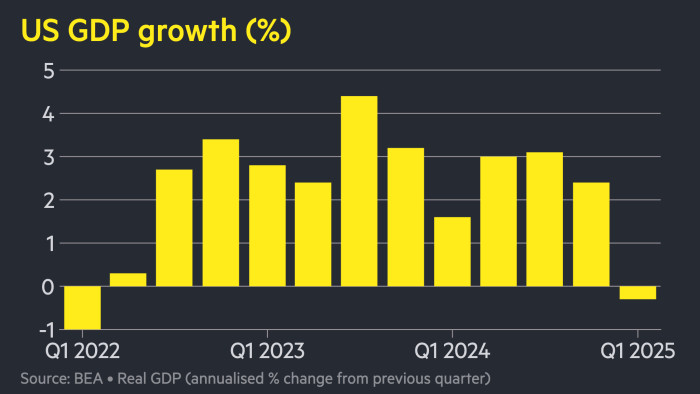Unlock the Editor’s Digest for free
Roula Khalaf, Editor of the FT, selects her favourite stories in this weekly newsletter.
The US economy contracted by an annualised 0.3 per cent over the first quarter, as companies in the world’s largest economy responded to Donald Trump’s trade war by rushing to import goods.
The fall in the GDP reading — the first since 2022 — was worse than economists’ most recent forecasts and compared with the 2.4 per cent rise for the fourth quarter.
It was largely the result of companies’ rush to buy goods from abroad ahead of the US president’s sweeping tariffs, with imports rising at an annualised rate of 41 per cent.
Many analysts argued that the headline GDP number was principally brought down by an extraordinary increase in the US trade deficit, rather than reflecting underlying trends.
The calculation used for Wednesday’s figure arrives at GDP by subtracting imports from total spending, including domestic consumption, investment and exports.
Morgan Stanley economists said the surge of imports ultimately contributed to inventories, consumption and investment — positive factors in calculating GDP that were not fully reflected in Wednesday’s data.
“In effect, the imports don’t fully appear in the spending parts of the GDP accounts and therefore exaggerate GDP weakness,” they said.
Some economists focus instead on other measures, such as investment and consumer spending.
Wednesday’s figures showed that the sum of consumer spending and gross private fixed investment increased 3 per cent in the first quarter, up on the previous rate of 2.9 per cent.
In a post on his Truth Social network, Trump suggested the figures had “NOTHING TO DO WITH TARIFFS”.
Blaming former president Joe Biden, he added: “I didn’t take over until January 20th . . . When the boom begins, it will be like no other. BE PATIENT!!!”
Acknowledging the stockpiling that took place ahead of Trump’s tariffs announcement this month, the Bureau of Economic Analysis, which produced Wednesday’s data, highlighted the rise in “private inventory investment”.
Without this contribution, the GDP figures would have contracted at an annualised rate of 2.5 per cent.
In a further indication of the scale of business’s efforts to import ahead of the tariffs, the US goods trade deficit reached a record high of $162bn for March in figures published this week.
Economists anticipate a measure of rebound in the second quarter as imports fall and previously stockpiled foreign goods are bought by US consumers.
Diane Swonk, chief economist at KPMG US, said that Wednesday’s GDP figure had been distorted by tariffs, adding that the “extraordinary impact” would unwind as imports fell.
But she also expected GDP to shrink further in the second quarter, because of tariffs’ impact on domestic demand — “and domestic demand is ultimately what you worry about”.
Cargo volumes from the Port of Los Angeles, the biggest dock on the US West Coast, are down 30 per cent this week, while next week’s volumes are expected to be more than a third lower than the same time last year.
Stock futures dropped and bond yields rose slightly following the data. The two-year Treasury yield, which moves with interest rate expectations, was up 0.01 percentage points to 3.66 per cent.
There was no significant shift in interest rate cut expectations following the data, with traders in the futures market still pricing in roughly four cuts this year.
The BEA said the fall in output for the first quarter also reflected a decline in government spending.
It added that consumer spending was also among the factors that partly, but not wholly, offset the increase in imports and the fall in government spending.
“The strong domestic demand figures are a poignant reminder of what might have been a graceful soft landing until the sweeping tariffs threw the economy off course,” said Eswar Prasad, professor at Cornell University.
Trump’s trade war is expected to lead to slower growth over the second half of this year, with higher prices weighing on consumption.
The IMF said last week that US GDP would expand by 1.8 per cent this year — down from its January estimate of 2.7 per cent. Many private sector forecasters predict no growth at all.
Additional reporting by Kate Duguid in New York



